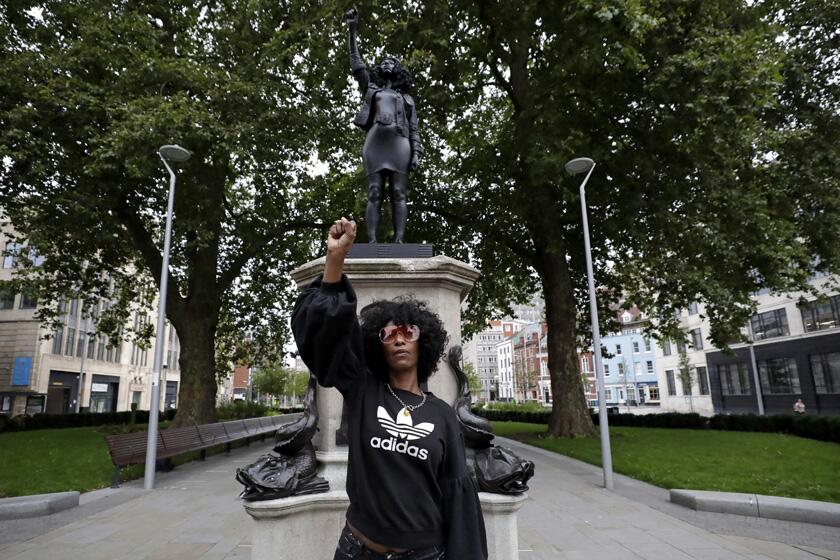35 years after her motherâs murder, a poet of Black struggle writes a monument
Natasha Trethewey tells me a ghost story. Years ago, on a research trip through her home state of Mississippi for her third poetry collection, âNative Guard,â she was staying in an antebellum mansion that had been converted into an inn. On her second night there, she awoke to a tense voice: âYou, sir, must understand my intent.â Seconds later, frozen in her bed, she felt âa depressionâ beside her, as if someone had sat down on the mattress. The presence then lay down and slung an arm over her. Tretheway stayed awake, unmoving, she says, âuntil I heard the train whistle that I knew was dawn.â She left that morning.
Strange occurrences seem to populate her life, she says by phone from her home in Evanston, Ill., on the sunny morning of Juneteenth: Chance phone calls with long-estranged family members; the coincidence of her own birth on the 100th anniversary of Confederate Memorial Day (April 26, 1966).
Then there was the spring evening in 2005 when Trethewey, out for dinner with her husband in Atlanta, struck up a conversation with a stranger, an assistant district attorney. Suddenly, he paused. âWas your mother Gwen Grimmette?â he asked. âWhen I look back at him,â she writes in her transcendent new memoir, âMemorial Drive,â âthere are tears welling in his eyes, and then he drops his head and weeps.â
In 1985, he was a police officer, the first on the scene when Tretheweyâs mother was discovered dead outside her apartment, with holes in her hand and head (as if the former could have stopped the fatal bullet). Now, almost 20 years later to the day, he offered to bring Trethewey a box of court documents that were about to be destroyed. Had they not met, she says, she likely never would have heard some of her motherâs last living moments â recordings she transcribed directly into âMemorial Drive.â
Trethewey is a famous poet, to the extent that one can be such a thing in 21st-century America. In 2007, she won a Pulitzer Prize for poetry for âNative Guard,â and five years later was named the nationâs poet laureate â recognized for work that shimmies the American Southâs history of racism right up alongside the palpable pleasures of its thousand shades of green. Flickering in between are visions of her mother â sometimes bruised, sometimes dancing.
She didnât open the box immediately, Trethewey says in her rich and deliberate voice. She knew what might haunt her from the box: âI mean, Iâve seen âLaw & Order.ââ The process of unpacking it and composing the memoir took seven years. âWhen I left Atlanta, vowing never to return,â she writes of the years immediately after the killing, âI took with me what I had cultivated all those years: mute avoidance of my past, silence and willed amnesia buried deep in me like a root.â
Maggie OâFarrell uses scant material on the Bardâs family tragedy to examine the struggles of his wife in a beautiful new novel, âHamnet.â
To tell her motherâs story â and her own as her motherâs child â she had to reclaim the totems and memories and documentary evidence of the years between 1973 and 1985, when Joel Grimmette, her stepfather and her motherâs killer, abused and tormented both of them. What she slowly pulled from that box included an autopsy report, crime-scene photos, court records and a letter written by the police officer guarding her motherâs apartment â whoâd left just before Grimmette, who had already threatened to kill her, showed up. âAnd that is the moment,â Trethewey says now, her voice clotting with emotion, âthat ... I donât know. I just kind of started wailing, because itâs all there. They could have saved her.â
She couldnât save her mother, but she could reanimate her memory and welcome her spirit back into her life.
Stone Mountain is nearly 1,700 feet high. Its massive bas-relief sculpture of Jefferson Davis, Robert E. Lee and Stonewall Jackson â a Confederate Mt. Rushmore, the largest of its kind â looms at the very end of the titular Memorial Drive, visible from the front gate of the apartment where Gwendolyn Ann Turnbough (her motherâs maiden name, the one Trethewey prefers) lived and died.
The mountain was carved to intimidate, to remind Black Georgians of their tenuous foothold on freedom. Sam Venable, its owner in the early 20th century, granted the incipient second wave of the Ku Klux Klan permission to hold a cross burning there on Thanksgiving Eve 1915. In a fit of racist pique, the state of Georgia bought the property not long after the Supreme Courtâs ruling in the landmark civil rights case Brown vs. Board of Education of Topeka. A few years later, Stone Mountain was officially opened to visitors on the centenary of Lincolnâs assassination.
âIt reminds me,â Trethewey writes, âof what is remembered here and what is not.â Memorial Drive, the avenue and the book, form a literal throughline from the public pain of Black Southerners to the private suffering of Tretheweyâs family.
Shouldnât public monuments have public input? In the George Floyd moment, artists and designers are changing the nature of monuments and the histories they honor.
Trethewey was born in Gulfport, Miss., to a white father and a Black mother whose marriage wasnât legally recognized in the state. (The Supreme Court struck down bans on interracial marriage the following year.) Until she was 6, Trethewey lived within sight of her great-aunts and -uncles, next to her grandmotherâs house, where âthe latest issue of Jet lay on the coffee table beside a photograph of the civil rights movement.â She lived a dual reality: âskipping between those housesâ gathering sunshine-yellow daffodils in the cocoon of her extended family; and then out on the streets experiencing the tension of being mixed race. With her father, she was accorded respect; with her mother, sneers and threats. A cross was burned on their lawn. âWhen I was growing up, if I did anything well, white people would always say things like, âOh, well, thatâs your white side.ââ
Her parents divorced, and in 1972, Trethewey, called Tasha by her family, joined Gwendolyn in Atlanta, arriving as it was transitioning into what she laughingly calls âa chocolate city.â (She kept in touch with her father, also a poet, but lived with her mother.) Trethewey writes with calm and quiet love of the school she entered there, a place where Black intellectuals and heroes were studied year-round and children performed James Weldon Johnsonâs âThe Creation.â Then Joel Grimmette came along.
Trethewey doesnât speak much during our conversation about the abuse her former stepfather brought into the family home. How he beat her mother at night and accidentally became the first audience for Tashaâs writing, cracking open her diary. Writing helped Trethewey evolve, but it hasnât healed her. âThis is just a state of being Iâm in these days,â she says at a tender moment in the conversation. âI did go to that difficult place.â
She went there in her poetry, albeit slant, for years. At the University of Massachusetts, where Trethewey got her masterâs in fine arts, a professor once advised her to âunburden yourself of being Black. Unburden yourself of the death of your mother, and write about the situation in Northern Ireland.â Of course, Trethewey disregarded this advice. Her race and her motherâs murder were, she says, her âtwo existential wounds.â
There is a twinning of documentary evidence and personal memory in much of Tretheweyâs poetry, as in âMemorial Drive.â âDomestic Workâ uses photographs of workers in the South to call up memories of âclotheslines sagged with linens,/ a patch of greens and yams,/ buckets of peas for shelling.â âBellocqâs Opheliaâ re-imagines a prostitute in Storyville (the old red-light district of New Orleans) sitting for real photographs and musing on her own exploitation â body and image. âIn my room,â she thinks, âEverythingâs a prop for his composition.â âNative Guard,â released in 2006, reported and magnified the stories of a Black Union Army regiment: âSome names shall deck the page of history/ as it is written on stone. Some will not.â Permanence â and what we choose to commemorate â has preoccupied Trethewey for decades.
âNative Guardâ was dedicated to Tretheweyâs mother, and after it won the Pulitzer, journalists mined the poetâs life for background material. She understands the impulse. âMy poems are rooted in my personal history, theyâre autobiographical,â she says. But the profiles usually mentioned her mother âalmost as this sort of afterthought, just this murder victim. And that wounded me, the way that she was constantly being portrayed, and I think even diminished.â
All day Iâve listened to the industry of a single woodpecker, worrying the catalpa tree just outside my window.
Justly or not, she wound up blaming herself. âI realized that I had committed this kind of same act of erasure⌠I had dedicated the book âTo my mother.â I did not include her name. So it was still just a monument to Natasha Tretheweyâs mother. ⌠Not Gwendolyn Ann Turnbough.â âMemorial Driveâ is a monument with a name.
The irony isnât lost on Trethewey that sheâs commemorating her mother â a career woman, a quiet revolutionary, a woman who gave her daughter room to thrive even in the throes of abuse â just as statues of unworthy men are being yanked down with ropes across the country. A friend in Georgia sent her a video of the removal of a Confederate monument outside the DeKalb County Courthouse, where Grimmette was sentenced to life in prison. âI wish I could have been there,â she says. To her, the symbolism matters. Three days after our second conversation, Mississippi legislators voted to remove the stateâs flag, which contains a Confederate symbol. All these totems are âa disservice to our humanity, and an ongoing disfigurement of the souls of white folk.â
But Trethewey doesnât want Stone Mountain dynamited into dust. âIâd like to find a way that we tell the fullest version of the racist history behind it,â she says. âSo that when people look at it, what they encounter is not just some message of Southern gallantry and heroism and nostalgia, but the real truth of what it symbolized.â To her, itâs not only a symbol of a distant Civil War but also one of recent history â Americaâs and her own. The monument was first commissioned in 1915, she reminds me, but wasnât completed until 1972, the year she moved to Atlanta with her mother.

âMemorial Driveâ essentially consists of three parts, dotted with small inflection points and snippets of dreams. It bears the contours of tortured memory: natural detours and unexpected chasms, vivid flashes and black holes. The first part deals with Tretheweyâs pre-Atlanta childhood, the second with those 12 years sheâd repressed. The third stakes out wild new territory. One section flits between first and second person â âthat is me,â she tells me, âtrying to confront myself about these years of willed forgetting ⌠How do you integrate the self again, when something has divided you?â
The book eschews the common memoiristic route of picking apart the aftermath of trauma. Trethewey doesnât write about Grimmetteâs sentencing, which she missed. âI was on my way there. I donât know if it was intentional. ... I got to the courthouse, but it was over.â She says she never even contemplated chronicling any of her life past 1985. There is no mention of Grimmetteâs recent release from prison after serving 34 years.
Instead, the closing chapters of âMemorial Driveâ are almost entirely in Gwendolynâs words; the grace and polish of the poetâs voice recedes to reveal a monument with an iron core.
In the files the assistant district attorney turned over to Trethewey, she found a 12-page handwritten letter police had discovered in her motherâs briefcase. In it, Gwendolyn explains, in a clear, unruffled style, exactly how she left her husband after, knife in hand, he told her âhe would be nice and let me choose the way I wanted to die.â This is followed by a 27-page transcript of the two phone calls she recorded with Grimmette â evidence of his threats for the district attorney â in the two days before he killed her.
Theyâre anguishing to read. Gwendolyn is a model of reason and calm, her voice as composed as Tretheweyâs, as she points out the impossibility of Grimmette compelling her to love him at gunpoint; she tells him, âIâve just decided that thereâs just some, some times in your life that you just have to make a stand.â
Trethewey says including the transcripts is âthe one thing I was nervous about doing ⌠[But] the proof is there in black and white. I could try to tell you how great my mother was, how calm, how resolute, how resilient, how lovely. And it would just sort of sound like a daughter saying that about her mother. ... I wanted you to see it yourself.â
Itâs an astonishing decision â to cede the stage to her motherâs words, unedited and practically bleeding on the page. Itâs an act of preservation and a reckoning. The photos and true histories in Tretheweyâs poetry tether her subjectsâ lives and avoid sentimentality; they become more real with her evocation, not less. âMemorial Driveâ is even more naked, a specimen of found poetry. After decades spent dotting her work with remnants of her mother, the fullest expression of Tretheweyâs grief was to offer up what sheâd found in that box.
Itâs no wonder that even as she cheers demolition of so many symbols of a racist past, Trethewey doesnât want Stone Mountain destroyed. Sheâs found value in looking directly at the origins of hate and grief and untold loss. Like any good poet, she quotes Rumi on this. âThe wound is the place where the light enters you.â
Kellyâs work has been published in New York Magazine, Vogue, the New York Times Book Review and elsewhere.
More to Read
Sign up for our Book Club newsletter
Get the latest news, events and more from the Los Angeles Times Book Club, and help us get L.A. reading and talking.
You may occasionally receive promotional content from the Los Angeles Times.







